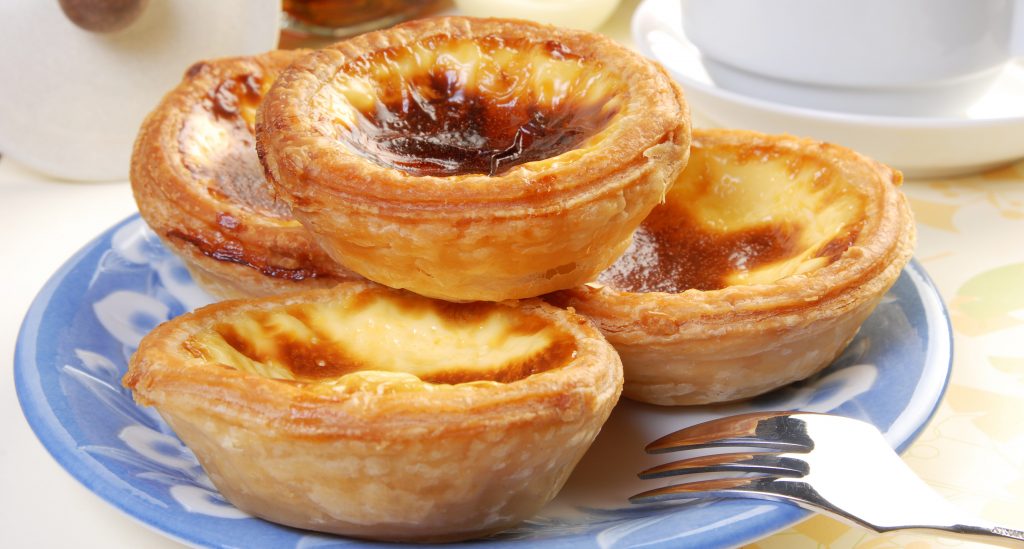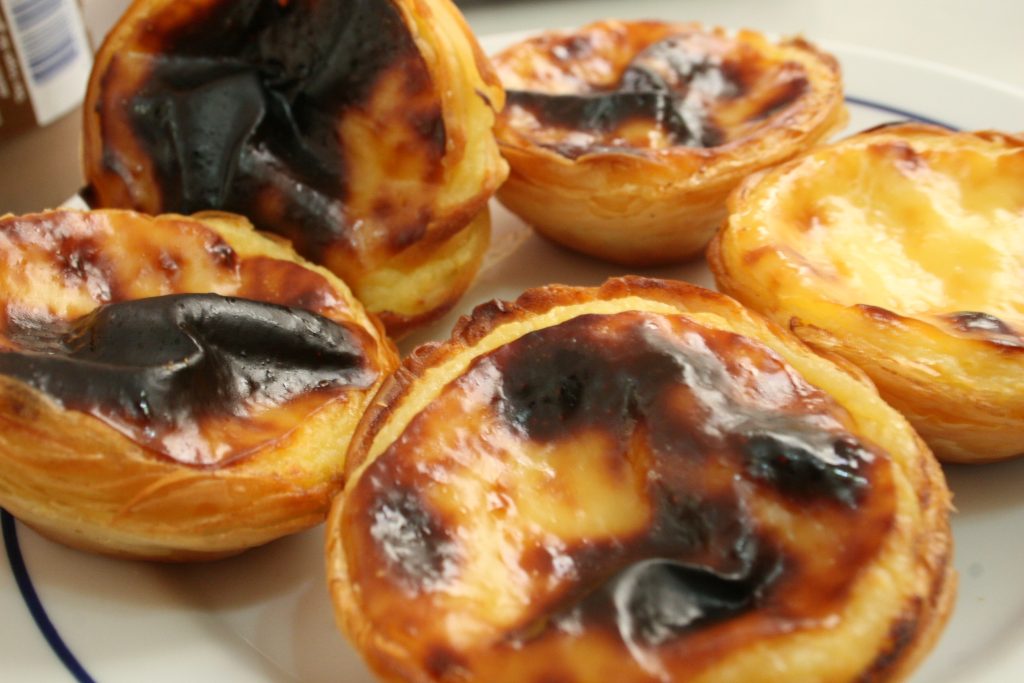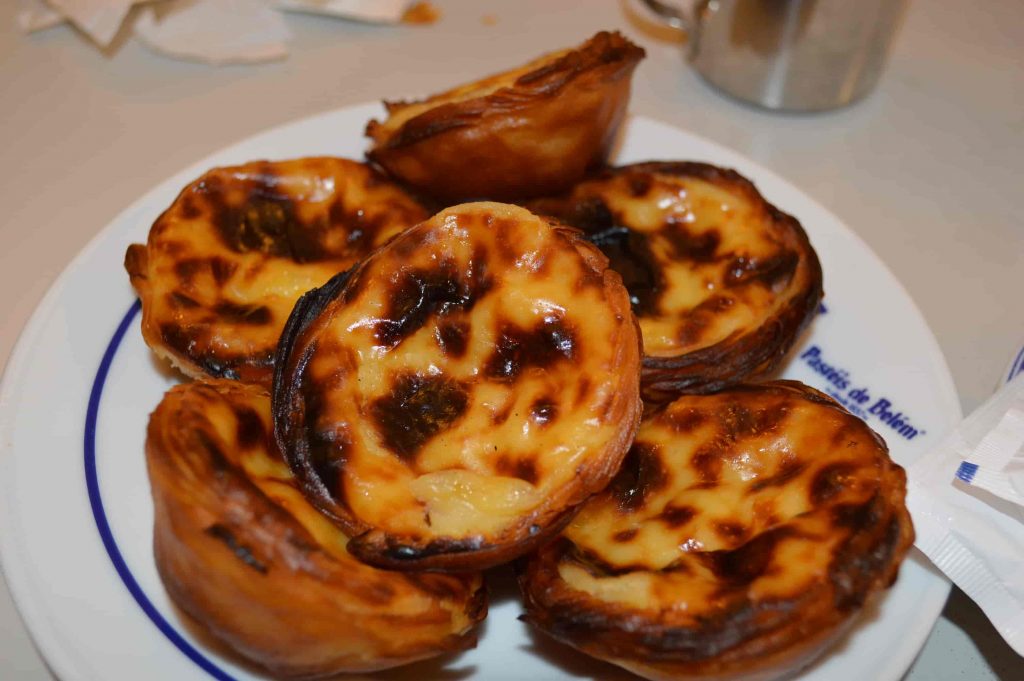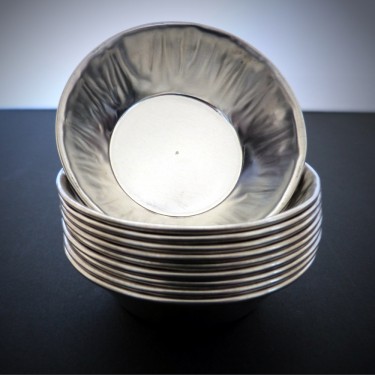Pastéis de Nata or Portuguese Custard Tart
Pastéis de Nata or Portuguese Custard Tart
This famous and popular Portuguese pastry originated in Belém, near Lisbonne but can be found all over Portugal and even worldwide. The Guardian’s “50 best things to eat in the world, and where to eat them” article placed the pastéis de nata in 15th position. Additionally, CNN‘s review of “The world’s 50 best foods” positioned the pastéis in 16th place.

Origin
Pastéis de Nata were created as a laundry by-product in the 18th century by catholic monks. Back then, the religious habits of monks and nuns were heavily starched with egg-whites. The leftover egg yolks served to prepare pastries and cakes. During the Liberal Revolution of 1820, prohibiting religious orders, monks needed to find alternative income sources. The Jeronimos Monastery closed in 1834. Hence, the famous recipe was sold and stayed in the nearby sugar refinery. In 1837, the owners of the refinery opened the Fabrica de Pastéis de Belém which has since remained in the hands of the same family for six generations. Today, only three family members know the secret recipe which is particularly well guarded.
Fortunaly Pastéis de Nata are sold in most bakeries across the country. However, these cannot be called Pastéis de Belém. Portuguese eat them at all times of the day with a cup of coffee. Pastéis de Nata are as much part of the Lusophone world at Fado and Saudade.

Here is a peak inside the famous Fabrica de Pastéis de Belém
Recipe – makes about 40 of these delicious pastries
Use your favorite puff pastry recipe or use ready-made puff pastry.
Ingredients for the Custard
- 3 tablespoons all-purpose flour or 27 g.
- 300 ml milk (1 1/4 cups)
- 260g granulated sugar (1 1/3 cups)
- 1 cinnamon stick
- 150ml water (2/3 cup)
- 1/2 teaspoon vanilla extract or 3 ml
- 6 large egg yolks, whisked
- For the garnish:
- Powdered sugar
- Cinnamon
Directions to Make the Custard
- In a medium bowl, whisk the flour and 65ml milk (1/4 cup) until smooth.
- Bring the sugar, cinnamon, and water to a boil in a small saucepan and cook until an instant-read thermometer shows 100°C (or 220°F). Do not stir.
- Meanwhile, in another small saucepan, scald the remaining 250ml milk (1 cup). Whisk the hot milk into the flour mixture.
- Remove the cinnamon stick and then pour the liquid sugar mixture in a thin stream into the hot milk-and-flour mixture, whisking briskly. Add the vanilla and stir for a minute until very warm but not hot. Whisk in the yolks, strain the mixture into a bowl, cover with plastic wrap, and set aside. The custard will be thin; that is as it should be. (You can refrigerate the custard for up to 3 days.)
Directions to Make the Pastéis de Nata (assemble and bake)
- Place an oven rack in the top third position and heat the oven to 290°C (550°F).
- Cover the nonstick pastry forms (*) with puff pastry leaving a raised thin lip above the form. The dough at the bottom of the pastry form should be thinner than on top. To do so, have a small cup of water nearby. Dip your thumbs in the water, then flatten the dough against the bottom of the cup. Then smooth the dough up the sides, leaving the raised lip.
- Fill each cup 3/4 full with the cool custard.
- Bake the pastries until the edges of the dough are golden brown. The time depends on the size of the pastry tins.
- Remove from the oven and allow the pasteis to cool a few minutes in the pan, then transfer to a rack and cool until just warm.
- Sprinkle the pasteis generously with powdered sugar, then cinnamon and serve. Repeat with the remaining pastry and custard. These are best consumed the day they’re made.
A pastel de nata is best enjoyed with a strong coffee or with a glass of medium sweet Madeira Wine. Be careful these pastéis de nata with either coffee or Madeira Wine can be highly addictive…

(*) There are special Pasteis de Nata tins in Portugal.

Only three people in Belém know the exact recipe of this delicacy. The recipe has been inspired by David Leite from Leiteculinaria.